Hi Mike, I saw an article you did with Maguires products by hand on an old Saturn. Now u did that by hand but I`m wondering if I could use same products with a Craftsman buffer and get still better results?
I know I wont get the same results using a buffer where I should be using a PC ,But I have a buffer and don`t have a PC.
I know the answer is I should just get a PC. Well until this one dies I`ll probably have to use it.
So what products will give the best results using only a Buffer?
I know some won`t break down with just using the speed of the buffer.
Also should I apply and work with terry cloth or MF bonnet?
Results 1 to 8 of 8
Thread: Question for Mike Phillips...
-
09-07-2010, 04:45 AM #1
Question for Mike Phillips...
-
09-07-2010, 01:53 PM #2
Re: Question for Mike Phillips...
If you can, post the link to the thread...
You might... the problem is I`m guessing you`re talking about a Traditional Orbital Buffer or a TOB?
I wrote an article about the TOB that explains why they won`t work for removing swirls out of clear coat paints...
The Traditional Orbital Buffer aka The Wax Spreader
Copyright ©PBMA - AutogeekOnline.net® All Rights Reserved
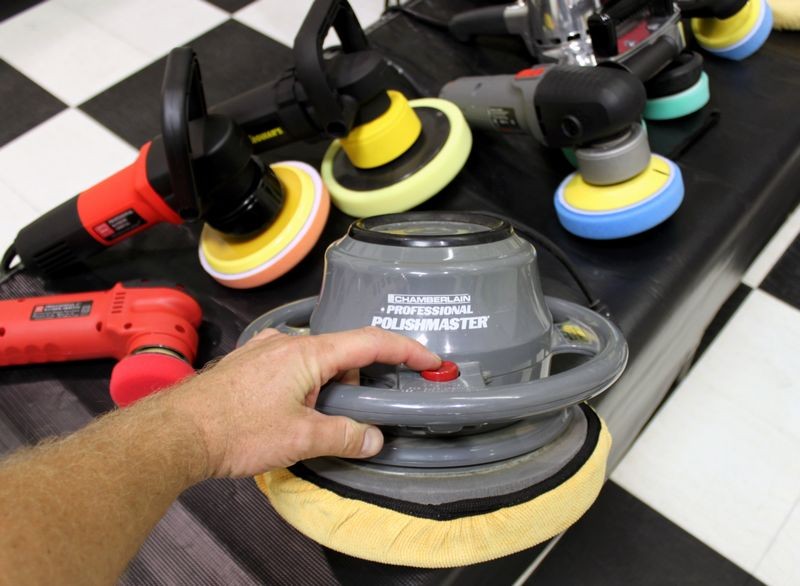
Traditional Orbital Buffers like the one in the picture above have been around for a long time, at least the 1950`s and probably the 1940`s, possibly earlier. In all the years I`ve been teaching classes on machine polishing I ALWAYS include these types of buffers only I don`t teach anyone how to use one, but instead teach people why they can`t use one to remove swirls out of clear coat finishes.
The reason for this is because chances are very good anytime you get together a group of approximately 30 car guys, (and car gals), chances are good at least one person in that group has a buffer like the one in the picture and chances are actually great that a number of people in the group have a buffer like this and/or have access to one or has been contemplating purchasing one.
These types of buffers are relatively inexpensive and easy to find at most department stores like Sears, Target, Walmart or K-Mart, and also most auto parts stores from around a low of $15.00 to a high of $70.00 and with most of them falling in somewhere in-between in the $30.00 dollar range.
Thus one reason so many people have one is because compared to the tools we all on detailing discussion forums talk about and use, these types of buffers are relatively cheap and easy to find. Tools like the Porter Cable 7424XP or a Flex 3401 more specialized tools capable of more dramatic results and are not easily found at the stores listed above.
Also, because the Traditional Orbital Buffer is easily found and relatively inexpensive to purchase, they are often given as gifts by well meaning people to their friends and family members that are into cars.
And here`s what this article is all about... for as long as I`ve been teaching classes the below question about these types of buffers always comes up,
"Mike, I already have an orbital buffer, can I use it to remove swirls?"
And specifically what they mean is that they`ve seen all the pictures and read all the threads showing people removing swirls and creating show car finishes using tools like the Porter Cable dual action polisher, (and the Meguiar`s and Griot`s versions), or the Flex 3401 Forced Rotation Dual Action Polisher or any of the popular rotary buffers like the DeWalt, Makita, Flex 603 or now days the Flex Lightweight 3403 and what they mean is can they get the same kinds of spectacular results they see people getting with these machines with the traditional orbital buffer they already own.
And then I get the fun of saying,
"No. I hate to be the bearer of bad news but the buffer you have won`t work to effectively remove swirls"
That`s a typical scenario and conversation that takes place in one of my classes and I`m sure I can get a witness from one of our forum members that has attended one of these classes after this thread is read enough times after I hit the Submit Button.
TOB = Wax Spreader
Reality is, these tools are now called Wax Spreaders because for the most part that`s all they`re really capable of, that is spreading out a layer of wax to a finish already in good condition. They don`t have enough power, speed or versatility to be used to remove swirls out of modern clear coat finishes. Now if your car`s finish is already in great condition and all you want to do is spread out a coating of wax then by all means use them as they will work for this purpose.
But if your car has a clear coat finish and has any of the below Below Surface Paint Defects then what you really need is a tool with dramatically better paint correction ability, that is the ability to remove these kinds of defects.
Cobweb Swirls also called Spiderweb Swirls

Rotary Buffer Swirls also called Holograms or Buffer Trails
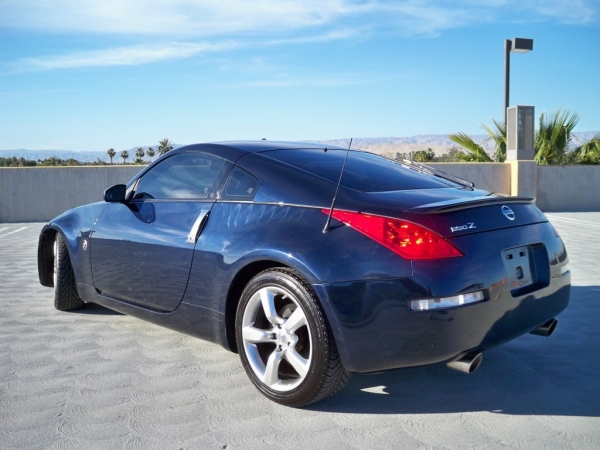
Water Spots
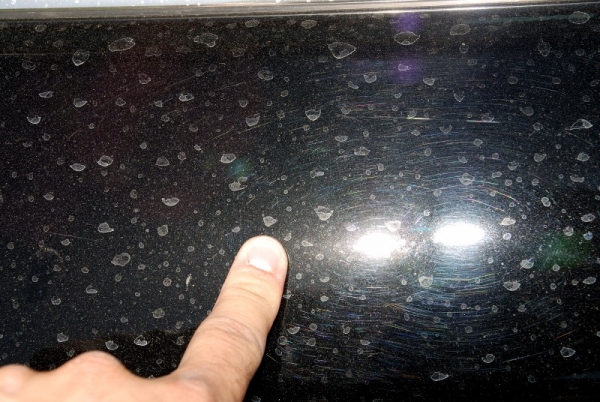
A little history on the Traditional Orbital Buffer
Back in the days when cars had single stage paints like lacquers and enamels, this would be pretty much most of the cars and truck built before the 1980`s, you could use a traditional orbital buffer to remove oxidation because these paints were generally speaking fairly soft. The problem with single stage paints is that if you don`t regularly polish and wax them, then the paint will begin to oxidize on the surface, this shows up as the paint turning a chalky, white color. For example, in the below picture the yellow paint on the 1960 Ford Ranchero has oxidized and begun to turn chalky white.
Oxidation on single stage yellow paint
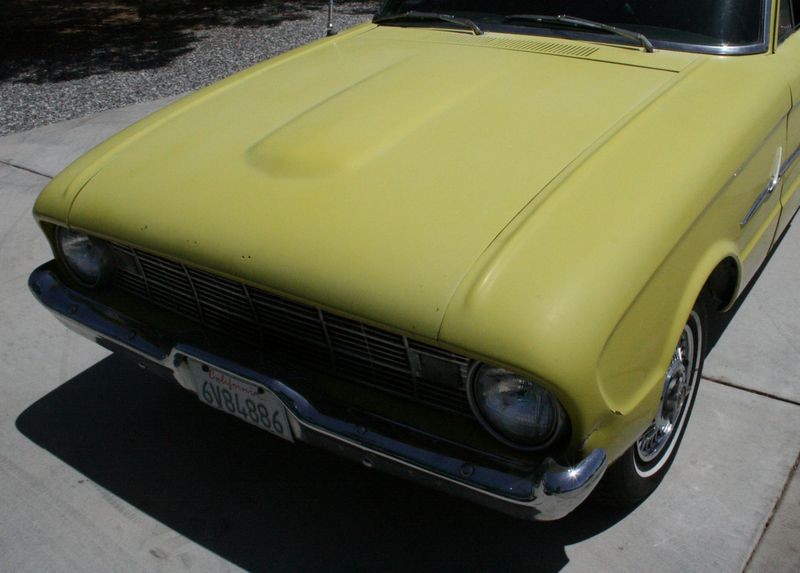
With old style single stage paints you could remove the oxidation by putting some rubbing compound on the face of a traditional orbital buffer and then place the buffer onto the oxidized paint and use this style of buffer to basically chew off the dead, oxidized paint and it worked pretty good! What you would do is use the buffer and the compound to chew off the dead, oxidized paint and uncover a fresh layer of paint and then afterwards you would polish and wax this fresh layer of paint and the results would be a restored finish that could look like this,
Oxidation removed off one half of the hood
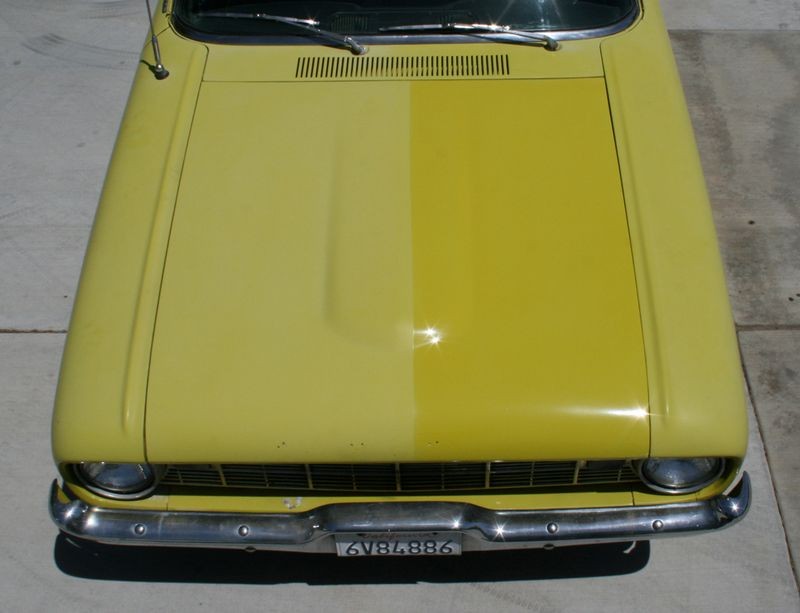
After all the oxidation has been removed off the entire vehicle and the paint has
been polished to a high glossed and then protected using a paint sealant.
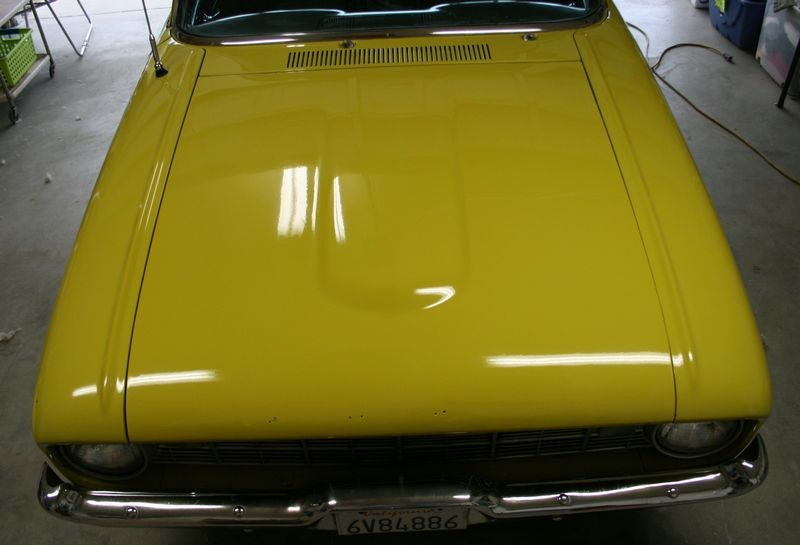
The paints have changed...
So old school buffers like a traditional orbital buffer worked find on old school paints. Here`s the deal though... the paints have changed! Since the early 1980`s car manufactures begin switching over to a new type of paint system called Clear Coat Finishes. There were some problems with early clear coat paint systems all th way into the 1990`s but today paint manufactures have this new paint technology dialed-in and modern clear coat paints now last a long time and bring the finish quality of cars to a higher level than ever achieved in the past.
Clearcoat paint systems use different types of resins or than traditional single stage paints and these new resins are more resistant to breaking down via oxidation and that`s a good thing because modern paints will easily last longer than traditional single stage paints with only a minimum of care such as washing and occasionally waxing or sealing the paint.
Swirls and Scratches instead of Oxidation
While modern clear coat paints don`t oxidize very easily they are easily swirled and scratched and the swirls and scratches show up easily to our eyes. The reason for this is because when you scratch a clear layer of paint the scratch isn`t clear it`s opaque or whitish and because the clear layer is sprayed over a layer of colored or pigmented paint, the darker colored paints act to make the swirls and scratches in the clear layer show up easily to our eyes.
Harder paints
One of the reasons modern clear coat paints are less prone to oxidize and can last longer then their predecessor is because they tend to be harder and more dense in their chemical make-up than single stage lacquer and enamel paints. This benefit comes at a cost and the cost is when you and I go out into our garage to try to remove swirls and scratches by hand it`s dramatically more difficult to remove swirls and scratches because of the hardness factor.
- Single stage paints get oxidation but because they`re softer it`s easy to remove the oxidation which is basically dead or deteriorated paint.
- Clear coat paints get swirls and scratches but because they tend to be harder than single stage paints it`s more difficult to remove defects in the paint.
Horizontal Point of View of Swirls, Scratches & Water Spots
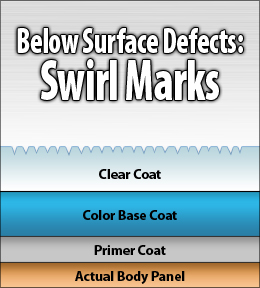
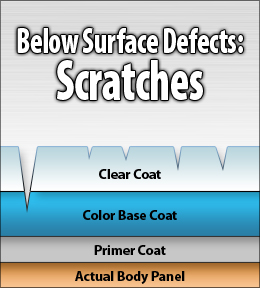
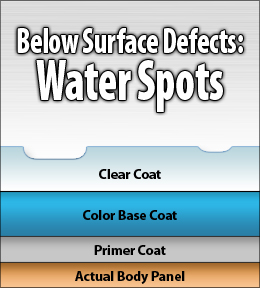
See this article for more information,
What it means to remove swirls, scratches and water spots out of automotive clear coats
Just to point out, removing oxidation means removing a little paint off the surface too so we`re all still doing the same thing when it comes to working on modern clear coat paints it`s just the difficulty has increased because the chemical make-up of the paint has changed.
The reasons why Traditional Orbital Buffers are not effective at removing swirls, scratches and water spots out of clear coat finishes.
Too little power
Most of the traditional Orbital buffers available today don`t have the same usable power that polishers like Porter Cable DA Polishers, Flex 3401 Polishers and Rotary Buffers offer.
Fixed speed buffers
Most of these tools have a simple On/Off button so you only get one speed out of the tool and usually it`s not fast enough to be effective at removing swirls.
Too slow
The fixed speed offered by traditional orbital buffers is too slow for effective removal of below surface. To be effective you want a polisher that offers a variable speed range with faster speeds at the high speed setting.
Tool large of a bonnet or face of buffing pad
The diameter of most of the buffing pads on traditional orbital buffers is too large and this makes the overall size or footprint of the polisher too large. What this means is when you apply some downward pressure to try to work a compound or polish against the paint to try to remove swirls, scratches and water spots, your downward pressure is spread-out over the entire surface of the buffing pad. This is limits and reduces the effectiveness and ability of the these types of buffers to remove paint and thus remove swirls, scratches and water spots.
Summary
All the reasons listed above are why traditional orbital buffers are simply not effective at removing swirls, scratches and/or water spots and have now days been relegated to the role of wax spreaders.
The good news is, there are plenty of powerful but safe options available to you with a huge assortment of buffing pads and backing plates as well as accessories to enable you to do the job yourself and remove below surface defects out of your car`s clear coat finish like swirls, scratches and water spots.
I`ve heard that a million times in my life... usually goes like this,
Person attends on of my classes, after we go through the class person raises hand and says,
"I don`t have a DA Polisher but I got this old buffer in my garage, can I get the same results using it"
I kid you not... that is how the conversation goes and it happens in almost ever classy. Then I explain what I wrote in the article above.
It will work but you could probably remove swirls faster by hand...
IF you want to give it a try, your best bet is with Meguiar`s Ultimate Compound, this is a SMAT product, so you don`t have to break any abrasives down. Simply apply to a small section at at time and run the polisher for about 2-3 minutes as long as you have a wet film of product on the surface.
I don`t think with these types of tools it matters which type of bonnet you use, I would probably try a microfiber bonnet as it will be more gentle to the clear coat than the cotton bonnet.
Work a section about 20" squarish or so... don`t try to tackle to large of an area at one time or you`ll end up doing nothing... you need the oscillating action with pressure, plus time in one small area in order to abrade the paint and polish it.
Do a test to one area and if you can make one small area look good you can make the entire car look good. If you can`t make one small area look good then yo won`t be able to make the entire car look good.
There`s an article on this forum I wrote that explains SMAT, do a search using the acrynom...
SMAT
 Mike Phillips
Mike Phillips
Host - Competition Ready on Velocity Channel
Director of Training Autogeek & Marine 31
Competition Ready Facebook Page
Mike Phillips Facebook Page
Twitter
Instagram
Click on a book to get your own copy.
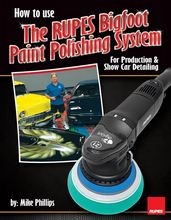
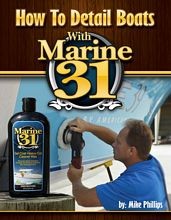

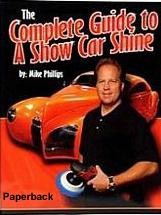
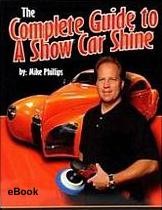


-
09-07-2010, 03:10 PM #3
Re: Question for Mike Phillips...
UHHHH...........Thanks?
No really I`ll try and find the article and post a link to it later.
-
09-07-2010, 03:48 PM #4
Re: Question for Mike Phillips...
Too much answer?
Your question/topic comes up a lot and in my article I do my best to explain while the old style buffers just don`t work as well as the new style buffers and that`s because the world changed paint systems.
We went from soft single state paints that would oxidize and you could use the TOB to remove oxidation to clear coat paints and these new paints are much harder compared to old single stage paints and for this reason the TOB or Traditional Orbital Buffer just doesn`t work as well.
The problem with clear coats isn`t oxidation, it`s swirls and TOB`s don`t remove swirls very well.
You can try and certainly should and if you have phenomenal results, please take before and after pictures then do a write-up and share your secrete to success!
Sounds good...
 Mike Phillips
Mike Phillips
Host - Competition Ready on Velocity Channel
Director of Training Autogeek & Marine 31
Competition Ready Facebook Page
Mike Phillips Facebook Page
Twitter
Instagram
Click on a book to get your own copy.







-
09-07-2010, 03:48 PM #5
Re: Question for Mike Phillips...
Also, does your buffer in fact look anything like this one?

 Mike Phillips
Mike Phillips
Host - Competition Ready on Velocity Channel
Director of Training Autogeek & Marine 31
Competition Ready Facebook Page
Mike Phillips Facebook Page
Twitter
Instagram
Click on a book to get your own copy.







-
09-07-2010, 04:45 PM #6
Re: Question for Mike Phillips...
Here is the link to the article I read yesterday.
1-Step vs 3-Steps - Auto Geek Online Auto Detailing Forum
and here is a picture of my craftsman polisher. Wax spreader buffer maybe even product waster..
I have gotten pretty good results but then again I have nothing else to compare to.
-
09-12-2010, 02:53 PM #7
Re: Question for Mike Phillips...
Thanks Mike !! Actually that what i wanted to know. I have one of those sitting next to me. Never really tried it, it was a passed down from a friend.
It didn`t look right so, it probably will be shinning my boots...
-
09-13-2010, 08:40 AM #8
Re: Question for Mike Phillips...
These types of polishers "can" work, it just depends upon your definition of the word "work".
If you want to remove massive swirls out of a clear coat finish a DA Polisher like the Porter Cable is a much more effective and faster tool...
I suppose with a enough time you could get the job done with a Traditional Orbital Buffer, (TO , but I could probably do the job faster by hand because I can exert a lot of pressure to a small area by hand and thus remove paint faster than this Craftsman Orbital Buffer.
, but I could probably do the job faster by hand because I can exert a lot of pressure to a small area by hand and thus remove paint faster than this Craftsman Orbital Buffer.
 Mike Phillips
Mike Phillips
Host - Competition Ready on Velocity Channel
Director of Training Autogeek & Marine 31
Competition Ready Facebook Page
Mike Phillips Facebook Page
Twitter
Instagram
Click on a book to get your own copy.







Thread Information
Users Browsing this Thread
There are currently 1 users browsing this thread. (0 members and 1 guests)
Similar Threads
-
Mike Phillips...NXT ? for you
By breakneckvtec in forum Epic ThreadsReplies: 92Last Post: 01-15-2016, 09:14 PM -
Mike Phillips...NXT ? for you
By breakneckvtec in forum Car Detailing Product DiscussionReplies: 84Last Post: 07-29-2010, 04:29 PM -
Question for Mike Phillips concerning new PPG paint job
By SPEEDYGUN in forum Car DetailingReplies: 1Last Post: 04-07-2004, 03:34 PM -
Question for Mike Phillips RE:NXT
By imported_vindaloo in forum Car Detailing Product DiscussionReplies: 28Last Post: 12-08-2003, 09:16 PM






 Reply With Quote
Reply With Quote
Bookmarks